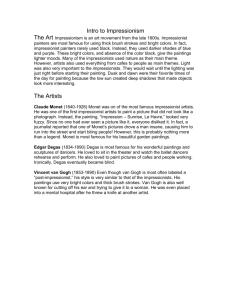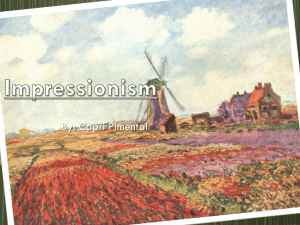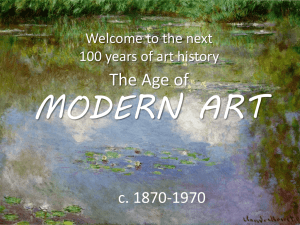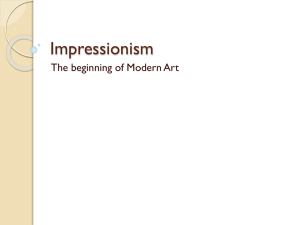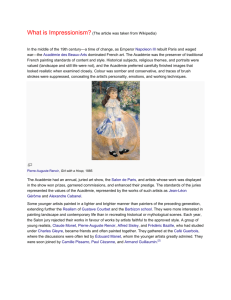Impressionism
advertisement
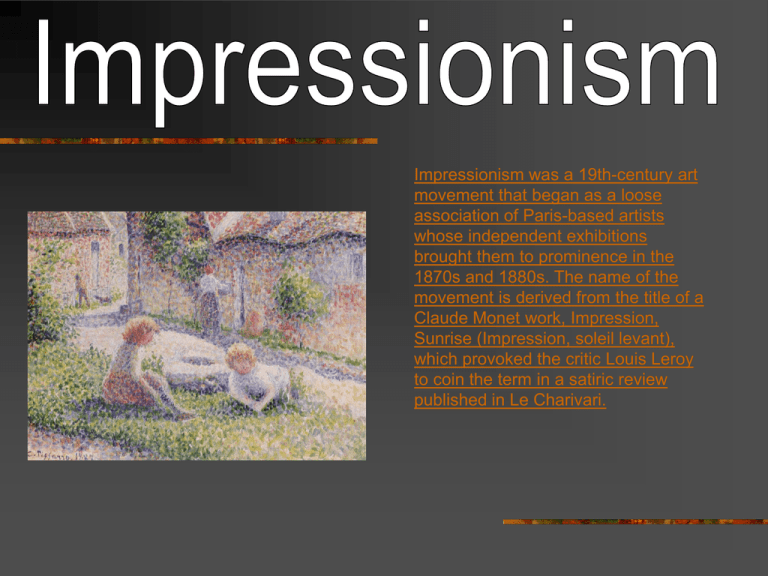
Impressionism was a 19th-century art movement that began as a loose association of Paris-based artists whose independent exhibitions brought them to prominence in the 1870s and 1880s. The name of the movement is derived from the title of a Claude Monet work, Impression, Sunrise (Impression, soleil levant), which provoked the critic Louis Leroy to coin the term in a satiric review published in Le Charivari. Beginning of Impression Era In an atmosphere of change as Emperor Napoleon III rebuilt Paris and waged war, the Académie des Beaux-Arts dominated the French art scene in the middle of the 19th century. The Académie was the upholder of traditional standards for French painting, both in content and style. Historical subjects, religious themes, and portraits were valued (landscape and still life were not), and the Académie preferred carefully finished images which mirrored reality when examined closely. Colour was somber and conservative, and the traces of brush strokes were suppressed, concealing the artist's personality, emotions, and working techniques. …Beginning continued The Académie held an annual, juried art show, the Salon de Paris, and artists whose work displayed in the show won prizes, garnered commissions, and enhanced their prestige. The standards of the juries reflected the values of the Académie, represented by the highly polished works of such artists as Jean-Léon Gérôme and Alexandre Cabanel. Some younger artists painted in a lighter and brighter manner than painters of the preceding generation, extending further the realism of Gustave Courbet and the Barbizon school. They were more interested in painting landscape and contemporary life than in recreating scenes from history. Each year, they submitted their art to the Salon, only to see the juries reject their best efforts in favour of trivial works by artists working in the approved style. A core group of young realists, Claude Monet, Pierre-Auguste Renoir, Alfred Sisley, and Frédéric Bazille, who had studied under Charles Gleyre, became friends and often painted together. They soon were joined by Camille Pissarro, Paul Cézanne, and Armand Guillaumin. …Beginning… In 1863, the jury rejected The Luncheon on the Grass (Le déjeuner sur l'herbe) by Édouard Manet primarily because it depicted a nude woman with two clothed men at a picnic. While nudes were routinely accepted by the Salon when featured in historical and allegorical paintings, the jury condemned Manet for placing a realistic nude in a contemporary setting.[3] The jury's sharply worded rejection of Manet's painting, as well as the unusually large number of rejected works that year, set off a firestorm among French artists. Manet was admired by Monet and his friends, and led the discussions at Café Guerbois where the group of artists frequently met. After seeing the rejected works in 1863, Emperor Napoleon III decreed that the public be allowed to judge the work themselves, and the Salon des Refusés (Salon of the Refused) was organized. While many viewers came only to laugh, the Salon des Refusés drew attention to the existence of a new tendency in art and attracted more visitors than the regular Salon. …Beginning… Artists' petitions requesting a new Salon des Refusés in 1867, and again in 1872, were denied. In the latter part of 1873, Monet, Renoir, Pissarro, and Sisley organized the Société Anonyme Coopérative des Artistes Peintres, Sculpteurs, Graveurs ("Cooperative and Anonymous Association of Painters, Sculptors, and Engravers") for the purpose of exhibiting their artworks independently. Members of the association, which soon included Cézanne, Berthe Morisot, and Edgar Degas, were expected to forswear participation in the Salon. The organizers invited a number of other progressive artists to join them in their inaugural exhibition, including the slightly older Eugène Boudin, whose example had first persuaded Monet to take up plein air painting years before.[5] Another painter who greatly influenced Monet and his friends, Johan Jongkind, declined to participate, as did Manet. In total, thirty artists participated in their first exhibition, held in April 1874 at the studio of the photographer Nadar. …Beginning… The critical response was mixed, with Monet and Cézanne bearing the harshest attacks. Critic and humorist Louis Leroy wrote a scathing review in the Le Charivari newspaper in which, making wordplay with the title of Claude Monet's Impression, Sunrise (Impression, soleil levant), he gave the artists the name by which they would become known. Derisively titling his article The Exhibition of the Impressionists, Leroy declared that Monet's painting was at most, a sketch, and could hardly be termed a finished work. He wrote, in the form of a dialog between viewers, Impression — I was certain of it. I was just telling myself that, since I was impressed, there had to be some impression in it … and what freedom, what ease of workmanship! Wallpaper in its embryonic state is more finished than that seascape. Techniques Short, thick strokes of paint are used to quickly capture the essence of the subject, rather than its details. The paint is often applied impasto. Colours are applied side-by-side with as little mixing as possible, creating a vibrant surface. The optical mixing of colours occurs in the eye of the viewer. Grays and dark tones are produced by mixing complementary colours. In pure Impressionism the use of black paint is avoided. Wet paint is placed into wet paint without waiting for successive applications to dry, producing softer edges and an intermingling of colour. Painting in the evening to get effets de soir - the shadowy effects of the light in the evening or twilight. Impressionist paintings do not exploit the transparency of thin paint films (glazes) which earlier artists built up carefully to produce effects. The surface of an Impressionist painting is typically opaque. The play of natural light is emphasized. Close attention is paid to the reflection of colours from object to object. In paintings made en plein air (outdoors), shadows are boldly painted with the blue of the sky as it is reflected onto surfaces, giving a sense of freshness and openness that was not captured in painting previously. (Blue shadows on snow inspired the technique.) Main Impressionists Frédéric Bazille, (1841-1870) Gustave Caillebotte (who, younger than the others, joined forces with them in the mid 1870s), (1848-1894) Mary Cassatt (American-born, she lived in Paris and participated in four Impressionist exhibitions), (1844-1926) Paul Cézanne (although he later broke away from the Impressionists), (1839-1906) Edgar Degas (a realist who despised the term Impressionist, but is considered one, due to his loyalty to the group), (1834-1917) Armand Guillaumin, (1841-1927) Édouard Manet (who did not regard himself as an Impressionist, but is generally considered one), (1832-1883) Claude Monet (the most prolific of the Impressionists and the one who most clearly embodies their aesthetic), [17] (1840-1926) Berthe Morisot, (1841-1895) Camille Pissarro, (1830-1903) Pierre-Auguste Renoir, (1841-1919) Alfred Sisley, (1839-1899) Impressionism beyond France The American Impressionists, including Mary Cassatt, William Merritt Chase, Frederick Carl Frieseke, Childe Hassam, Willard Metcalf, Lilla Cabot Perry, Theodore Robinson, Edmund Charles Tarbell, John Henry Twachtman, and J. Alden Weir. Walter Richard Sickert and Philip Wilson Steer were well known Impressionist painters from the United Kingdom. The Australian Impressionists, including Frederick McCubbin and Tom Roberts who were prominent members of the Heidelberg School and John Peter Russell a friend of Van Gogh, Rodin, Monet and Matisse as well as Rupert Bunny, Agnes Goodsir and Hugh Ramsay. Lovis Corinth, Max Liebermann, and Max Slevogt in Germany Konstantin Korovin and Valentin Serov in Russia Francisco Oller y Cestero, a native of Puerto Rico and a friend of Pissarro and Cézanne William McTaggart in Scotland. Laura Muntz Lyall, a Canadian artist Władysław Podkowiński, a Polish Impressionist and symbolist Nazmi Ziya Güran, who brought Impressionism to Turkey Chafik Charobim in Egypt Eliseu Visconti in Brazil Martins Krumins in Latvia, Germany and the United States. Joaquín Sorolla in Spain Fernando Fader, Martín Malharro, Ramón Silva in Argentina Post Impressionism Post-Impressionism developed from Impressionism. From the 1880s several artists began to develop different precepts for the use of colour, pattern, form, and line, derived from the Impressionist example: Vincent van Gogh, Paul Gauguin, Georges Seurat, and Henri de Toulouse-Lautrec. These artists were slightly younger than the Impressionists, and their work is known as post-Impressionism. Some of the original Impressionist artists also ventured into this new territory; Camille Pissarro briefly painted in a pointillist manner, and even Monet abandoned strict plein air painting. Paul Cézanne, who participated in the first and third Impressionist exhibitions, developed a highly individual vision emphasising pictorial structure, and he is more often called a post-Impressionist. Although these cases illustrate the difficulty of assigning labels, the work of the original Impressionist painters may, by definition, be categorised as Impressionism.
